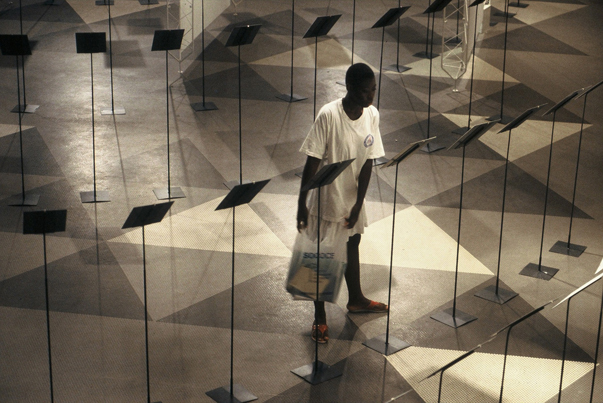It is not by thirst that the crocodile…
Third stage of Legend(s), « It is not by thirst that the crocodile comes out of the river to go on shore lick the morning dew » continues the process initiated in 1994 in an ordinary French suburb confronted to racism, then carried on in Bosnia-Herzegovia during the war.
Original photographic portraits taken by Maryvonne Arnaud in different African cities are sent to writers from Africa who live further and further away from the place where the photos have been shot. It is up for them to tackle with these portraits of unknown faces and to catch the elusive, the invisible, the unreadable, through captioning them..
« Legend(s) » deals with otherness, that is to say the dreadful process of affabulation produced by each meeting with the face of others. The intuitive stories of the associated poets help us to break cover the isolationism in order to discover the stranger without eliminating disorder, uncertainty, without clarifying or prioritizing.The associated writers were Pius Ngandu Nkasham, Patrick Chamoiseau, Tanella Boni, Kangni Alemdjrodo, Ahmadou Kourouma, Jean Luc Raharimanana, Tierno Monénembo, Frédéric Bruly Bouabré, Mazisi Kunéné, Leila Sebbar, Aminata Sow Fall and Abdourahman Waberi.
Created in Abidjan, this travelling exhibition was displayed in Dakar, Cotonou, Lomé, Niamey, Bobo-Dioulasso…
ORIGINAL TEXTS:
Ici, dans le cercle de tous les vertiges, tu as marqué la présence d’une légende surgie des temps qui n’existent plus.
Puisque tu portes un calicot blanc traversé des fables initiatiques. Puisque sur ton front apparaît un signe imperceptible qui indique les versants des montagnes rêvées. Puisque le collier de ta barbiche blanche ramène la mémoire vers les bosquets interdits. Puisque ton regard…, mais pourquoi ne hurle-t-il pas dans la tempête, ton regard ? Mais pourquoi ne peuvent-ils pas exister, ces temps lointains ?
Pius Ngandu Nkashama
===============================
Tout possible.
Mais le vivre déjà
compte semailles trop amères.
Et la joie innocente
suppute les fleurs tombées.
Patrick Chamoiseau
===============================
J’ai vu mille choses de mes yeux-miroirs
J’ai entendu mille versions des exploits de mon homme
Dans les rues de la ville
Je ne sais plus où il a traîné ses vies multiples
D’homme du grand jour d’homme de la nuit
Des milliers de sourires l’accueillent à chaque pas
Je passe ma vie unique à l’attendre
A regarder le temps qui me gave me dévore
Au seuil de quelle demeure a-t-il ôté ses babouches
Je ne sais pas s’il sera là demain
Je travaille de mes mains du matin jusqu’au soir
Je tisse le pagne de son absence infinie
Mais ma peau de soleil ignore
La tristesse de l’absence la paresse de la présence
J’attends avec joie le retour du conquérant
Tanella Boni
===============================
Rat des villes. Rat des villes shooté à “Santa Barbara” et “Dallas”. Villageois planétaire, évidemment. Coxeur. Apprenti-chauffeur. “Coiffeur diplômé de Paris”. Mécanicien d’enfer. Philosophe urbain. Dealer. Tireur du diable… sapeur. Don Juan. Inventeur. Soukousseur. Chair à canon. Imitateur. Machin vitriolique historiquement fiché, toujours ségrégué, Black is beautiful. Beautiful, jeune, et désenchanté. Black vit au cœur de la ville grise, l’interminable labyrinthe le long duquel s’allument et s’éteignent les phares de son improbable modernité. Black a l’air d’un taxi collectif abandonné en pleine autoroute, et qui attend son pétrole pour repartir butiner l’horizon des quadratures. Des millions d’années, déjà, qu’il attend. Alors, de temps en temps, il klaxonne et allume les phares du taxi en panne.
Kangni Alemdjrodo
===============================
Nous sommes riches, trop riches en terres, en enthousiasme, en paroles, en danses. Trop pourvus pour devenir miséreux comme ils le prédisent. Ce n’est pas par manque d’eau que le crocodile sort du fleuve pour aller sur la berge lécher la rosée du matin.
Ahmadou Kourouma
===============================
Au fond de l’abîme des amours, baigné de la senteur des tranquillités, je suis l’être en dérive qui attend d’échouer entre tes seins.
Jean Luc Raharimanana
===============================
Ni Ponant
Ni Levant
Mais les failles d’un dos fouetté par les pluies
Les brûlures d’un ventre qui, croit-on, a fini de donner
L’amour d’une vie sèche par absence d’amour
C’est par-là qu’il faut aller le chercher
le charme délétère du soleil
Tierno Monénembo
===============================
Cet homme ne serait pas “né” s’il avait su d’avance la réelle condition de cette terrestre vie. Sa tenue symbolisant la “civilisation européenne”, l’horreur qu’exprime son “visage” semble décrire irréfutablement la diabolique panique dans laquelle se déroule la “Guerre européenne”.
Frédéric Bruly Bouabré
ORIGINAL PORTRAITS :












